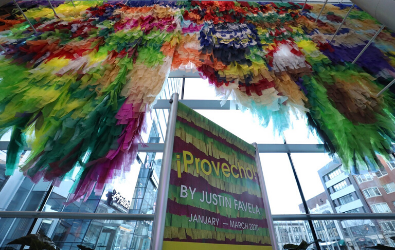When you think of nonprofit brand messaging, art probably isn’t at the front of your mind. However, visual representations of your message such as paintings, performances, and sculptures can serve a far more powerful purpose than simply being on display for aesthetic enjoyment. Human beings are visual creatures, and what we see is a form of common language that we share with others who see the same thing. Here are three different types of art that your organization can utilize to elevate your messaging to the next level:
- Temporary Public Art – This can be a mural painted on a building wall, a sculpture in a park, a huge window display made of everyday objects, or anything else you’d like it to be. With a bit of research, permission from landowners and the city officials, and a dose of creativity, public art can be a handy tool for conveying your organization’s mission to an entire city all at once. For example, nonprofit art curator Now + There’s most recent public art project in Boston centers around Latinx food, which sparks a conversation on culture and representation.
- Dramatic Performances – When your organization seeks to raise awareness of social justice or cultural issues that may be difficult to explain in concise terms, a dramatic performance will give your audience living examples of the issues you’re addressing. For instance, Prison Performing Arts is a nonprofit dedicated to improving literacy rates, communication skills, and discipline among Missouri’s incarcerated population by having program inmates perform classic plays such as Antigone and Hamlet. The hook? All plays performed revolve around tragedy caused by characters’ actions, which causes both the actors and the audience to reflect on their own lives and how they can avoid having a similar fate. When people see others go through emotions that they may have experienced themselves at one point, they are much more likely to form a connection to your story than if you had just preached your mission outright.
- Wearable Art – If your organization produces merchandise or artwork with a unique thematic design that clearly communicates your cause, you will have a much easier time attracting an audience than if others knew your organization by name only. For example, Eden Ministry raises awareness and funds by selling a few select designs of jewelry made by trafficking survivors they helped. Each piece bears a symbolic pendant and the maker’s story written on the back of the packaging, which makes them identifiable as being part of Eden Ministry. Since Eden sells their jewelry regularly at school fairs, they have gained notable recognition among students and teachers at the schools they visit. People who are aware of Eden’s mission and unique designs will immediately recognize their pieces on another wearer, which creates a halo effect for those who wear them.
Now that you know how to incorporate different types of art into your nonprofit brand strategy, go forth and start creating. At the end of the day, it’s all about having your audience connect with your organization by seeing it through your eyes.


